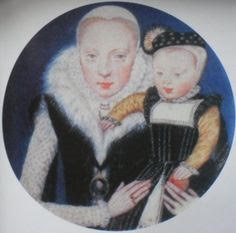 "The battle for the throne isn't over yet" is the tagline of Philippa Gregory's latest Tudor novel, The Last Tudor. Released yesterday, this novel focuses on the Grey sisters: Jane, Katherine and Mary, who, of course, had claims to the throne through their grandmother Mary Tudor, daughter of Henry VII.
"The battle for the throne isn't over yet" is the tagline of Philippa Gregory's latest Tudor novel, The Last Tudor. Released yesterday, this novel focuses on the Grey sisters: Jane, Katherine and Mary, who, of course, had claims to the throne through their grandmother Mary Tudor, daughter of Henry VII.
The lives of these three young women were explored in one of my all-time favourite history books, The Sisters Who Would Be Queen by Leanda de Lisle. It is a wonderful book. It's meticulously researched and highly readable, a winning combination, and deserves pride of place on every Tudor history lover's bookshelf. Philippa Gregory's novel is actually inspired by Leanda's research so I'm looking forward to reading this novel. To celebrate the release of Philippa's novel, Leanda has kindly shared the following excerpt from The Sisters Who Would Be Queen with us today:
"On 10 October 1562, when Elizabeth was at Hampton Court, she had begun to feel unwell, with aches and pains in her head and back. She had decided to have a bath and take a short walk to shake it off. When she returned to her chambers, however, she became feverish. A physician was called. To Elizabeth's irritation he diagnosed the potentially deadly Small Pox. Since there were as yet no blisters, she refused to accept the diagnosis, but sickness and diarrhoea followed and she became delirious. By 16 October the Queen could no longer speak. On the 17th she was unconscious.
Elizabeth had been on the throne almost four years: only a year short of her sister's reign. If she died, as many feared she would, how would her reign have been remembered? Elizabeth's religious settlement was not viewed as settled by anyone save the Queen. One of her own bishops called it ‘a leaden mediocrity’. In military matters, while Mary I's loss of Calais is still remembered, Elizabeth's failed efforts to recover Calais by taking Le Havre and using it as a bargaining tool, are completely forgotten. The campaign had ended that August 1562, with the huge loss of 2000 men. Most troubling at the time, though, was what was likely to happen next. Mary I had named Elizabeth as her heir, despite her personal feelings towards her sister, and so allowed the crown to be inherited peacefully. Elizabeth continued to refuse to name anyone. Instead, when she woke up briefly, believing she was dying, she asked for Robert Dudley to be made Lord Protector with an income of £20,000. Her Councillors promised her wishes would be fulfilled, but behind the scenes they had begun to argue furiously how the succession should actually go.
As the frantic arguments continued, the pox blisters on Elizabeth's body began to appear. They broke first in Elizabeth's throat and mouth, before spreading outwards to her face and body. But she began to feel better and after a few days she could speak again. Now she faced renewed pressure to settle the issue of the succession once and for all. The Council was determined to address the controversy during the coming parliament and Elizabeth remained most concerned about the threat posed by Lady Katherine Grey and her son.
Elizabeth looked magnificent at the procession for the state opening on 12 January, all golden hair, and red velvet. It was a wise Queen who appeared, ‘most royally furnished.. knowing right well that in pompous ceremonies a secret of government does much consist, for that people are both naturally taken and held with exterior shows. The rich attire, the ornaments, the beauty..held the eyes and hearts of men dazzled between contentment and admiration’. But Elizabeth bore the scars of small pox, a reminder that while her life had hung by a thread, so had the fate of her kingdom.
A debate on the succession began immediately with a petition soon drawn up, humbly requesting Elizabeth to marry, while also insisting that, even if she did so, she must name an heir. Elizabeth's reply to the Lords reminded them fiercely that the marks she now had on her face left by small pox weren't wrinkles and that, like the aging St Elizabeth, mother of John the Baptist, she could still have children. If she declared a successor, she warned, ‘it would cost much blood in England.’ Yet the debates continued, and as they did so the shocking news broke that, in the Tower, the imprisoned twenty-two-year-old Katherine Grey was about to have a second child.
It emerged that in May Katherine's husband, Ned Hertford, had managed to bribe two guards to unlock his door and those to Katherine's nearby chambers. On the 24th they had spent an hour making love on her bed, with its covers of silk shot damask. Four days later he had returned, and once again they had lain together.The guards had then got cold feet, or someone senior had got wind of what had occurred. When Hertford had visited his wife on a third night he had found the door to Katherine's rooms locked. He had not been able to return, but evidently those two nights had been enough for Katherine to conceive. It would be difficult to now deny they were married. They had been interrogated by the Archbishop of Canterbury and senior councillors on their marriage, and told them all they considered themselves man and wife. Under canon law this stated intention followed by intercourse was a marriage.
At 10.15 on the morning of 10 February 1563 Katherine delivered another son, named Lord Thomas Seymour. Elizabeth ordered the Lieutenant of the Tower be imprisoned in one of his own cells for his failures in keeping Hertford locked up, but ordinary people were demanding, ‘Why should man and wife be [prevented] from coming together’? Elizabeth persisted, however, in refusing to recognise the marriage, and come the summer, when a virulent plague hit London, Elizabeth took the opportunity to move the couple out of the Tower to separate and far-flung country houses.
Katherine desperately missed Hertford, ‘I long to be merry with you, as I know you do with me, as we were when our sweet little boy [Thomas] was begotten in the Tower’ she wrote of their lovemaking, ‘I wish you to be as happy as I was sad when you came to my door for the third time, and it was locked. Do you think I can forget what passed between us? No, I cannot. I remember it more often than you know. .. such is my boundless love for my sweet bedfellow, that I once lay beside with joyful heart and shall again’. Katherine pleaded with the Queen for her forgiveness, but she was kept apart not only from Hertford, but also from her elder son.
A miniature of Katherine with the infant Lord Beauchamp (see image at the top of this post), painted at around this time by the female court artist, Levina Teerlinc, remains the earliest known portrait of an English mother with her baby: a sad reminder for Katherine of all she had lost. But for others it represented the future: an icon of a Madonna carrying the Lord's anointed, the next King of England. Copies were made and even after four hundred years several still survive. Katherine and Hertford had many friends who hoped that the Queen yet could be pressured into naming Katherine, or one of her sons, as her heir."
Thank you so much, Leanda, for sharing that excerpt. If that has piqued your interest in Katherine Grey and her sisters then here are the details for the two books:
The Sisters Who Would Be Queen: The Tragedy of Mary, Katherine and Lady Jane Grey
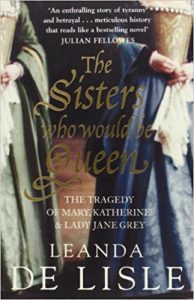 The dramatic untold story of the Grey sisters, heirs to the Tudor throne.
The dramatic untold story of the Grey sisters, heirs to the Tudor throne.
‘Leanda de Lisle brings the story of nine days’ queen, Lady Jane Grey and her forgotten sisters, the rivals of Elizabeth I, to vivid life in her fascinating biography’ Philippa Gregory
Lady Jane Grey is an iconic figure in English history. Misremembered as the ‘Nine Days Queen’, she has been mythologized as a child-woman destroyed on the altar of political expediency. Behind the legend, however, was an opinionated and often rebellious adolescent who died a passionate leader, not merely a victim. Growing up in Jane’s shadow, her sisters Katherine and Mary would have to tread carefully to survive.
The dramatic lives of the younger Grey sisters remain little known, but under English law they were the heirs – and rivals – to the Tudor monarchs Mary and Elizabeth I. The beautiful Katherine ignored Jane’s dying request that she remain faithful to her beliefs, changing her religion to retain Queen Mary’s favour only to then risk life and freedom in a secret marriage that threatened Queen Elizabeth’s throne.
While Elizabeth’s closest adviser fought to save Katherine, her younger sister Mary remained at court as the queen’s Maid of Honour. Too plain to be considered significant, it seemed that Lady Mary Grey, at least, would escape the burden of her royal blood. But then she too fell in love, and incurred the queen’s fury.
Exploding the many myths of Lady Jane’s life and casting fresh light onto Elizabeth’s reign, acclaimed historian Leanda de Lisle brings the tumultuous world of the Grey sisters to life, at a time when a royal marriage could gain you a kingdom or cost you everything.
Click here to find out more about Leanda's book.
The Last Tudor
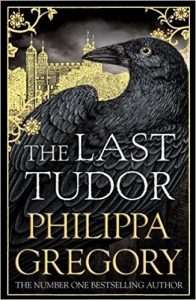 ‘How long do I have?’ I force a laugh.
‘How long do I have?’ I force a laugh.
‘Not long,’ he says very quietly. ‘They have confirmed your sentence of death. You are to be beheaded tomorrow. We don’t have long at all.’
Jane Grey was Queen of England for nine days. Using her position as cousin to the deceased king, her father and his conspirators put her on the throne ahead of the king’s half-sister Mary, who quickly mustered an army, claimed her crown and locked Jane in the Tower. When Jane refused to betray her Protestant faith, Mary sent her to the executioner’s block. There Jane turned her father’s greedy, failed grab for power into her own brave and tragic martyrdom.
‘Learn you to die’ is the advice that Jane gives in a letter to her younger sister Katherine, who has no intention of dying. She intends to enjoy her beauty and her youth and find love. But her lineage makes her a threat to the insecure and infertile Queen Mary and, when Mary dies, to her sister Queen Elizabeth, who will never allow Katherine to marry and produce a potential royal heir before she does. So when Katherine’s secret marriage is revealed by her pregnancy, she too must go to the Tower.
‘Farewell, my sister,’ writes Katherine to the youngest Grey sister, Mary. A beautiful dwarf, disregarded by the court, Mary finds it easy to keep secrets, especially her own, while avoiding Elizabeth’s suspicious glare. After watching her sisters defy the queen, Mary is aware of her own perilous position as a possible heir to the throne. But she is determined to command her own destiny and be the last Tudor to risk her life in matching wits with her ruthless and unforgiving cousin Elizabeth.
Click here to find out more about Philippa's novel.

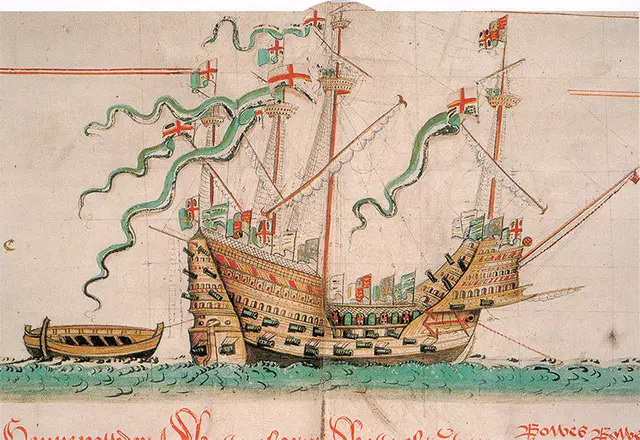
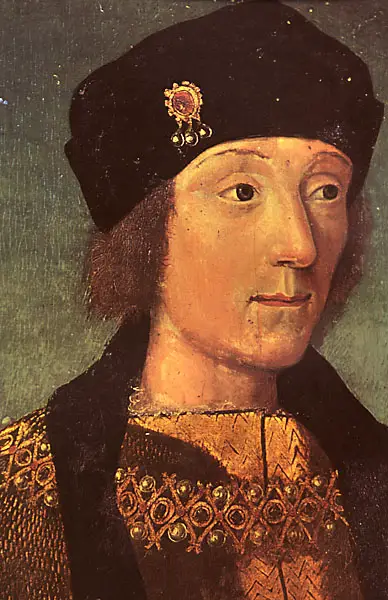
why is Katharine ‘s grandmother Mary Stuart referred to as her step grandmother in the last Tudor